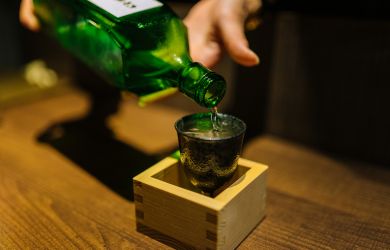
Originally published on metropolis.co.jp on March 2012


Beyond the usual destinations in Japan, rich with history and natural beauty, exists another layer of locations long of fascination to a certain inquisitive breed of people. These are haikyo, or “ruins”—abandoned, decayed manmade structures—which, in the age of seemingly limitless info-technology, provide a yet undiscovered territory.
The language barrier and lack of comprehensive information about locations have long kept the hobby out the reach of many non-Japanese. Even most Japanese would have to invest a lot of time, effort and money to find anywhere suitable. The seminal Nippon no Haikyo (2007), edited by Ryoji Sakai, has made the pastime more accessible. Often viewed as the bible of haikyo exploration, the book not only contains information about more than 200 ruins located in Japan, but also includes detailed maps.
Though only available in Japanese, Nippon no Haikyo has become a hot commodity among a growing group of non-Japanese enthusiasts. One such individual is Michael John Grist, a science fiction and fantasy author who grew up in North-West England, surrounded by dilapidated mills left over from the age of coal and cotton.
“Back then, whenever an interesting place presented itself I’d explore opportunistically,” says Grist. On coming to Japan, he hardly expected this activity would become more than that. Until, that is, he encountered an article about a Japanese haikyo enthusiast. “If there were books about it, there had to be plenty of locations to explore,” he continues. “I bought the books, and visiting urban ruins became my hobby.”
Grist’s first outing in Japan was to a fenced-off apartment block near an elementary school in which he was teaching at the time. Despite wearing a suit, the burning curiosity and adrenaline rush saw him climb over the barbed wire fence and tear his trousers to shreds in the process.
haikyo hazards
In addition to the gray legal terrain, explorers need to be aware of deteriorating surroundings to avoid injury.
Floors
Floors can be waterlogged and rotten. Strong walking boots are recommended over comfortable sneakers, which will not provide
much support if a floor gives way.
Staircases/walkways
Avoid stepping on rotten concrete or rusted staircases that might not take your weight. On staircases, keep your weight balanced, take one step at a time, and maintain a firm hold on any rails or beams that look reliable.
Glass/nails
Broken glass and protruding nails can be easily overlooked in darker locations. Again, strong boots are recommended, as rubber soles will not provide much protection against sharp objects.
Toxic substances
A gas mask or particle filter is recommended to avoid inhaling any dangerous substances, such as asbestos, or gas released from mounds of dried bird droppings.
People
Haikyo’s increasing popularity means you might bump into other adventurers, or even film crews. Inform them of your presence immediately to avoid startling anyone.
“For me, it was a great reprieve from the daily boredom,” he says.
Initially a mobile phone was enough for Grist to snap the rarely-seen sights, but he has since succumbed to the norm in the field and invested in a professional-grade DSLR camera.
Michael Gakuran’s interest in urban exploration also began among hidden corners of his native England. Here in Japan, the coordinator of international relations found a way to rediscover the thrill he felt as a child exploring caves and other forgotten places. He also has a handy way to practice his photography skills—a common trait among the haikyo breed.
As opposed to the ruins he visited as a child in his home country, the relatively unspoiled nature of them in Japan was a draw for Gakuran. “Rather than damage due to vandalism, many haikyo here show the true process of degradation and natural decay, which can be breathtaking at times,” he comments.
One example was an old, abandoned medical shack in the remote countryside containing treasures such as bottles with mysterious powdered medicine, a box of blood samples, books on German medical practice, and an unusual decapitated doll.
“Very often we don’t get to see the stage between creation and demolition, and looking at the way man-made materials decay is an humbling experience,” Gakuran says. “Fear is another emotion I often feel, as well as the helplessness of being alone in a vast structure.”
Grist’s most powerful experience was at the former Sports World site located on the Izu Peninsula in Shizuoka Prefecture. This water amusement park was opened in 1988, in the heady days of the economic Bubble. The country’s subsequent collapse ultimately led to Sports World’s bankruptcy in 1996. However, its remote location meant there was no rush to redevelop the land, and the park remained disused—until its fame grew among the haikyo community.
“The first time I went it was like entering an alien land,” Grist remembers. He spent the night alone in one of the untouched hotel rooms with a sleeping bag he’d brought. “It was thrilling to enter in the dark, to walk around afraid of all these bizarre night-jungle noises,” he says. “Waking up to a glorious dawn felt surreal, and also stunning, that I had this whole park and the gorgeous view of trees and mountains to myself.”
Unfortunately, Sports World was finally knocked down in early 2010. It now remains only in the memories and photos taken by the intrepid explorers who ventured there—and in the regrets of those who didn’t, such as Gakuran. For his part, Grist wishes he’d managed to see Gulliver’s Kingdom amusement park in Yamanashi Prefecture—renowned for its giant figure of the fictional explorer—before it was torn down in 2007 after six years of abandonment.
Following the devastating earthquake and tsunami of 3/11, large portions of the Tohoku coastline have been left damaged and uninhabited, presenting a dilemma to haikyo enthusiasts. On one hand the region could provide a rare glimpse into a place where time has stopped. On the other, the moral issue remains of visiting areas where many people recently lost loved ones and their livelihood.

Additionally, there is a new element of danger resulting from the Fukushima nuclear disaster. A parallel situation in the Ukraine has been overcome by increasing numbers of visitors keen to scope out the Chernobyl disaster site. Whether Fukushima will one day see its own legions of the curious remains to be seen.
Grist believes visiting Tohoku as an urban explorer would be “too ghoulish,” remembering the casualty reports of last March. “To go stalking through all that like any other haikyo would feel horrible,” he shivers. Gakuran did visit Tohoku in May, but he went to see how the area was recovering from the disaster. “It felt strange looking around the ruins there because these weren’t buildings abandoned or left to decay naturally,” he says. In place of the forlorn feeling he usually experienced from looking at abandoned buildings, he found himself overcome with shock.
The realization made him rethink the haikyo process. “There was a different force at work in the aftermath of the tsunami, and it didn’t feel right to present it as a typical exploration.”
See more of the discussed haikyo heads’ work at the below links:
- Michael John Grist: www.michaeljohngrist.com
- Michael Gakuran: http://gakuranman.com
- Jordy Theiller (provider of Sports World photo): www.meow.fr

Nippon no Haikyo
The book that started it all is out of print, but about 20 copies are still available from the publisher, Hakkaku Bunkakaikan, at: www.hakkaku-culture.info (Japanese). Hakkaku Bunkakaikan plans to revive some Nippon no haikyo content in a new magazine this summer.





